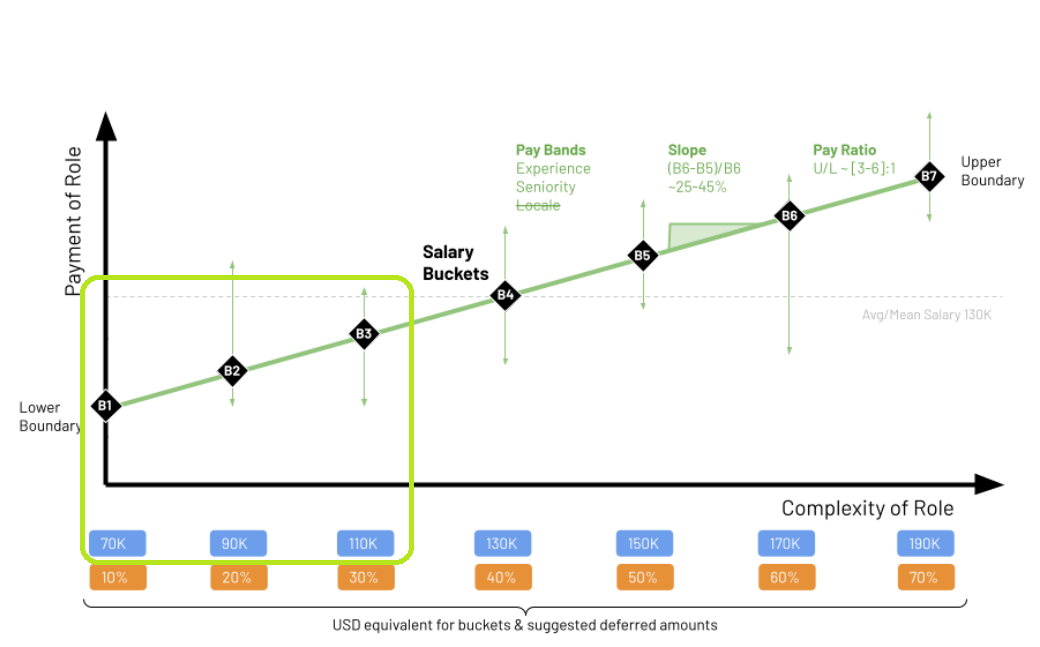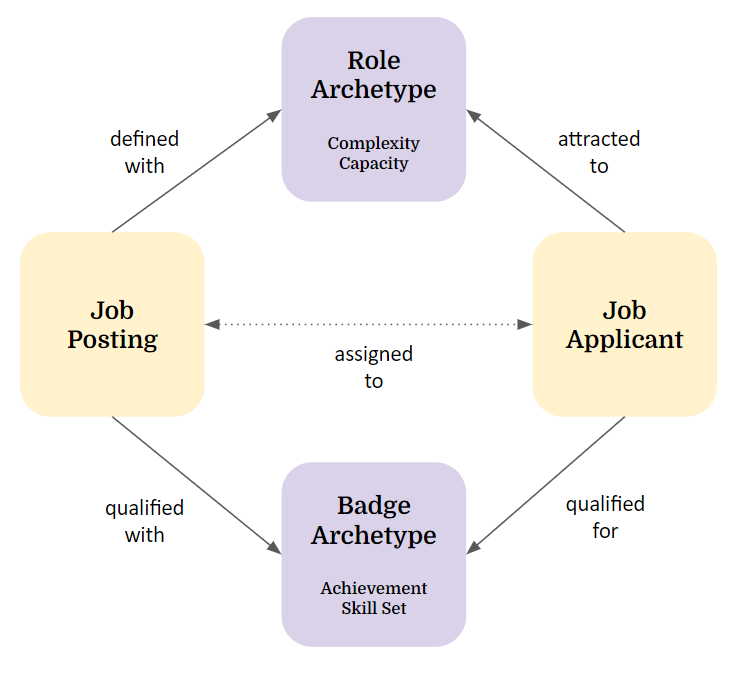Samara's Compensation Model
Need to rethink the premise - this book isn't about creating a new civilization (maybe part 2) - JS
Premise
Compensation
The compensation in Samara is based on a token mix that consists of of SAMARA (equity/value token), SVOICE (voting weight token), HUSD (USD equivalent token), and possibly Seeds currency, if a reserve exists. This mix is determined by a "formula" that converts the USD Equivalent into the right mix of tokens. See the Samara Token page for more details on each of the tokens in use.
Compensation for contributors
Currently every contributor to Samara is compensated in the following way:
- 1$ contribution can be compensated with either 1 SAMARA or with 1 HUSD (these are the only two token types currently available in Samara)
- Contributors request the HUSD they need to cover their fiat currency needs. (This is intended to allow people to free up their energy and time to contribute to Samara by covering the living costs they would otherwise have to invest time and energy elsewhere to cover.)
- The rest of their contribution (Total contribution - HUSD amount requested) is compensated in SAMARA, which is then multiplied according to the current multiplier
- The multiplier exists to reward Contributors taking on the risk of uncertain future value of SAMARA over the known, immediate exchange value of HUSD. This multiplier will gradually decline as Samara’s value as an organization increases, inherently increasing the value of the SAMARA equity token and reducing risk in choosing compensation in SAMARA.
Example:
- One contributor has a $5,000 contribution in a lunar cycle. They only need $1,000 HUSD to cover their living expenses that must be paid in fiat currency.
- The $5,000 contribution is compensated with $1,000 HUSD and 4,000 SAMARA. The 4,000 SAMARA are multiplied by the current multiplier (1.8 as of 4/16/21). 4,000 x 1.8 = 7,200 SAMARA
- $5,000 contribution --> $1,000 HUSD + 7,200 SAMARA
Compensation for investors
$1 investment = 1 SAMARA, multiplied according to the active multiplier.
Current distribution of tokens to contributors and investors
The current way Samara allocates tokens is through this Compensations Spreadsheet . This is far from ideal but works as a record of all the contributions to Samara until the DHO is operational. It details historical contributions and earned compensation, including and the exact amounts of SAMARA, HUSD and SVOICE.
Salary Bands
Defining a salary for a role is an extremely difficult task to do. There are many, many variables involved in finding a fair and equitable salary for everyone in the organization.
For these early stages, Samara is using three salary bands, namely B1 ($70k/year), B2 ($90k/year) and B3 ($110k/year). These bands are directly connected with the commitment levels, B1 for up to 49%, B2 for 50% - 79% and B3 for over 80%. 
Commitment
We define commitment as “mindshare” - not how many hours per week you work on an assignment. This is a new, challenging concept for many people used being valued by the hour and living in a society largely organized around the 40 hr M-F work week.
Here’s how we think about mindshare:
- For a given time period, like a lunar cycle, there exists a limit to the amount of fully present and focused awareness you can provide to things other than what you need to give attention to for sustaining your health and wellbeing. This usually includes things like sleep, rest, relaxation, exercise, meditation, time in nature, fulfilling personal and familial responsibilities, and honoring commitments to yourself and your community.
- Your limit can only be determined by your own honest reflection.
- If you commit all your awareness under this limit, you would commit 100%. • If reserve half of this awareness for a part-time job, education, or hobbies, you could then commit up to 50% to your work with Samara.
- Finally, Commitment is provided to specific quest(s) and/or role(s) rather than generally to Samara. For example, you may decide to commit 30% to Quest A over one lunar cycle, but also commit 50% to Quest B, lasting 3 lunar cycles. While both A&B are active, your total commitment to Samara will be 80%, but your compensation level may be different for A&B. If you don’t take on another quest once A expires, your total commitment to Samara will be 50%.
Members propose their commitment at the start of the cycle period and self-assess their actual contribution level after the cycle period ends. As well, Samara conducts a Collective Evaluation, a community building exercise where the team comes together to assess each other’s’ contributions – both their perceived quality and demonstrated commitment level.
This Collective Evaluation is not intended to dispute contributors’ honesty or create a hidden, hegemonic equation that determines the “true” relationship between amount of visible “work” and commitment level. It is intended to provide an opportunity for teammate feedback to be incorporated into self-reflection, and for invisible work, effort, awareness to be made visible and receive social recognition. Contributors retain complete autonomy to keep their original commitment level, or adjust it up or down after Community Evaluation.
Minimum commitment in Samara is 30% for regular assignments. Please note that your total level of commitment for the sum of all assignments cannot exceed 100%.
Commitment vs Contribution - future model
There is a new pattern arising with the introduction of contribution accounting (a co-evaluation process in which all participants openly rate contributions of everyone else). Personal commitment levels can vary widely from day to day, but what we "see who showed up for the work" is pretty clear and in front of us. With contribution accounting, we can move from personal commitment (what I think I did) to collective contribution (what we think you did). This step gives us an opportunity to explore an "open ceiling of human potential" - we simply don't know yet how far our passion can take us (think flow states, eudaimonia, potentiality, dream states, etc). All what counts is if you "where there and brought value back to the collective", how you got that value is not relevant (maybe you were in a flow state and received a download!).
Note that this pattern only works for group contributions like quests, not for individual contributions and roles that are more predictable, pre-determined and personal ("I am committed to this role in a 50% capacity"). We do have the option of due diligence during quarterly reviews ("I haven't seen you around for a while, are you still at 100%?") but those tend to lean towards performance tracking, a pattern we want to stay away from. However, even we are planning to introduce a drastic change - dynamic commitments allow you to adjust you current level on a weekly, even daily basis ("I am going away for the rest of the day", I will take the next few days off"). This requires a high levels of trust and openness in the organization, which is exactly the foundation of Samara.
Lastly, dynamic commitments and the separation of commitment from contribution level resolves a critical bottleneck in this organization - let's say you have an assignment at 100% commitment; it is impossible to add more work (as it should be), but if you temporarily reduce the commitment to 90% (via dynamic commitment) you can join a quest and take full advantage of contribution accounting - now the collective decides how to decide on the payouts of the quest pie and if you had a deep insight during the quest, you will be fully rewarded!
Future models for role and badge archetype
The goal is to match qualified applicants with open job postings. In traditional job markets, this process is overtaxing, one-sided, prone to trial & error and a guessing game between pretense & perception. In a decentralized human organization, we are using role archetypes as attractors for applicants and badge archetypes as qualifiers for applicants to optimize the matching process and to reduce bias. Role archetypes represent the complexity of the job and the capacity of the organization to support positions (e.g. the organization might have room for 5 storytellers at a complexity level of B3). Badge archetypes represent achievements and skillsets of applicants. Both archetypes are used to find the right applicant for the assignment.
Salary Bands - future model
- $70k annual salary converted into an average hourly rate @ 40hr week
- minimum 30%+ time commitment
- Relatively Low Complexity (B1) - focused on doing - minimal time sensing and on calls - maximum time DOING!
- 60/20/20 - Doing / Sensing / Learning (within one circle)
Complexity/Intensity Recognition Rewards:
- ($70k) +$20k
- minimum 50%+ time commitment
- Requires much more headspace and managing overlapping topics, issues, information etc. Supporting multiple individuals. Completion of 2 lunar cycles on universal pay required before eligible. Availability subject to organization's capacity and budget.
- 40/40/20 - Doing / Cultivating (Sensing & Coordinating) with multiple individuals & circles / Learning
- Fellow circle members vote to recognize
- ($70k) +$40k
- minimum 80%+ time commitment
- Samara is your primary focus and devotion. Supporting and serving multiple circles, individuals, and the movement effectively. 3 months of universal/B2 pay required before eligible. Availability subject to organization's capacity and budget.
- 20/60/20 - Doing / Cultivating (Sensing & Coordinating) with multiple circles & organizations / Learning
- Entire organization votes to recognize

